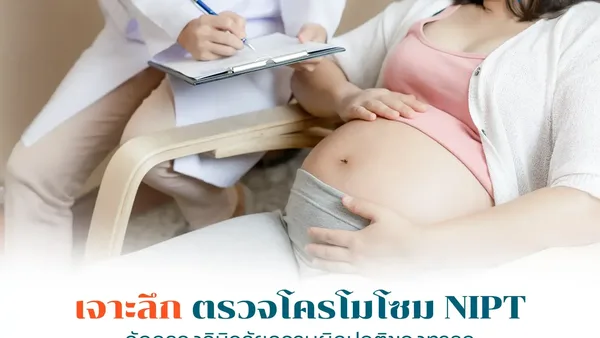IVF (In Vitro Fertilization)
IVF is one method of treatment for individuals facing infertility, whether due to genetic factors or underlying health conditions. This advanced medical technology helps make having children possible for those who wish to start a family.
What is IVF (In Vitro Fertilization)?
IVF, or In-Vitro Fertilization, is a process of fertilization outside the body, commonly known as "test tube baby." The term "test tube baby" comes from the process in which a woman’s egg (female reproductive cell) is selected and combined with sperm (male reproductive cell) in a medical laboratory. Once fertilization occurs and the embryo develops to the blastocyst stage (around day 5), it is transferred back into the woman’s uterus.
Although the term "test tube baby" is not widely used in Thailand and many people are still unsure about what IVF or test tube baby really means, it is important to understand that both terms refer to the same process. The term simply differs by name or convenience of usage.
What is ICSI and how is it different from IVF?
ICSI (Intracytoplasmic Sperm Injection) is an additional step in the fertilization process. Normally, with IVF, sperm and eggs are placed together in a lab dish and left to fertilize on their own. In contrast, ICSI involves selecting the strongest sperm and directly injecting it into the egg using a specialized technique. This method increases the chances of successful fertilization. ICSI is also considered a type of "test tube baby" procedure, just like IVF.
Difference between IVF/ICSI and GIFT?
In the past, a common treatment for infertility was GIFT (Gamete Intrafallopian Transfer). This procedure involved making three small incisions in the patient’s abdomen to insert a camera and place sperm close to the egg for fertilization. However, the success rate was only about 20%, and the downside was that the patient had to undergo abdominal surgery with three incisions. If it failed, repeated surgeries were necessary.
GIFT has been around for a long time but is now rarely used. Nowadays, IVF/ICSI has replaced GIFT because it has a higher success rate, does not require abdominal surgery, and allows fertilization to happen outside the body. However, IVF/ICSI requires advanced, safe laboratories that follow strict standards, which means higher costs due to the expensive setup.
IVF Procedure Steps
The IVF procedure consists of 6 steps as follows:
- Consultation with a fertility specialist
The doctor will explain the procedure and important information for patients preparing for IVF or ICSI treatment. Each case has different steps and risks, so the doctor will create a personalized treatment plan. (It is best to come before your menstrual period starts.) - Ovarian stimulation injections
Once ready for IVF treatment, the doctor will check hormone levels through blood tests and perform ultrasound scans. Hormone injections to stimulate egg production will begin on day 2-3 of the menstrual cycle. Patients will need to self-inject these hormones daily at the same time. If a patient is afraid of needles or cannot inject themselves, Beyond IVF offers free nurse-administered injections at the clinic. During this phase, regular ultrasounds and blood tests monitor egg growth and hormone levels, adjusting medication as needed to optimize results. This step usually takes about 10-12 days. - Egg retrieval and sperm collection
When the eggs have matured to the desired size, the doctor will retrieve eggs by using a needle inserted through the vagina, under short sedation or anesthesia to prevent pain. The procedure takes about 20-30 minutes. The male partner will provide a sperm sample, which will be processed to select the healthiest sperm for fertilization with the eggs in the laboratory. - Embryo culture
Specialized lab staff will carefully monitor the fertilized eggs as they develop into embryos. Embryos are cultured until they reach the stage of 6-8 cells and continue growing to a strong blastocyst stage (day 5 embryo), which is the most advanced stage current technology allows. Beyond IVF cultivates embryos up to this blastocyst stage. - Embryo transfer
This crucial step involves placing the healthiest embryo back into the woman’s uterus. The doctor will discuss and decide with the patient which embryo to transfer. The procedure is done by the doctor; the male partner can be present. There is no surgery or anesthesia involved. - Pregnancy testing
Beyond IVF monitors patients after embryo transfer by checking hormone levels every 3 days. If hormone levels drop, medications or injections will be given to support hormone levels. Pregnancy results are typically known 14 days after the embryo transfer.
Suitable Timing for Embryo Transfer
Embryo transfer is a very important step and also the final step in the IVF process. This step involves placing the fertilized embryo back into the woman’s uterus to achieve a successful pregnancy as planned. Embryo transfer can be done at specific times as follows:
- Blastocyst transfer: This involves culturing the embryo externally with advanced technology until it reaches the blastocyst stage, which takes about 5 days after fertilization. Then, the embryo is transferred back into the uterus. This method increases the chances of successful implantation and thus improves pregnancy rates.
- Day 3 transfer: This involves culturing the embryo for only 3 days after fertilization until it reaches the 6-8 cell stage. Then the healthy embryo is transferred back into the uterus.
Who is IVF suitable for?
- Women aged 35 years and older
- Women with blocked or damaged fallopian tubes
- Women with ovulation disorders
- Women with endometriosis
- Women with extensive pelvic adhesions
- Couples with genetic abnormalities
- Men with low sperm count or poor sperm quality
- Cases of unexplained infertility
Preparation for Parents Before IVF
Preparation for Women:
- Undergo a physical examination for treatment assessment, preferably on day 2-3 of the menstrual cycle
- Ovary check: The doctor may test estrogen hormone levels along with ultrasound during the first days of menstruation to evaluate ovarian response to stimulation drugs
- Uterus check: Ultrasound to examine the uterine cavity or hysteroscopy for better decision-making on the best fertilization method
- Get enough rest
- Avoid drinking tea and coffee
- Avoid alcohol and smoking for at least 3 months before treatment
- Inform the doctor about any underlying diseases and bring current medications for doctor’s review
Preparation for Men:
- Abstain from ejaculation for 5-7 days before visiting the doctor
- Avoid alcohol and smoking for at least 3 months before treatment
- Exercise regularly, but not excessively
- Avoid wearing tight underwear
- Avoid hot baths and sauna sessions
- Manage stress and maintain a relaxed mind
Self-care After IVF
- After embryo transfer, rest at the clinic for 2 hours
- Normal daily activities can be resumed
- Avoid heavy exercise
- Avoid lifting heavy objects
- Avoid eating foods that may cause diarrhea
- If you have a fever, painkillers can be taken
- Avoid sexual intercourse and vaginal douching
- Engage in relaxing activities and avoid stress as it affects hormone levels
- If you experience abnormal symptoms such as abdominal pain, bleeding, or excessive vaginal discharge, see your doctor immediately
- Another recommended method for preventing infertility in the future is egg freezing (oocyte cryopreservation)
Advantages and Disadvantages of IVF/ICSI
Advantages of IVF/ICSI:
- Currently, it has the highest success rate.
- Can treat a wider variety of fertility problems.
- No abdominal surgery required; it is non-invasive.
- Women who have had tubal ligation can still undergo the procedure.
- Men with low sperm count below standard can still use this method.
- Chromosomal testing of embryos (NGS) is possible.
Disadvantages of IVF/ICSI:
- Higher cost compared to IUI.
- The process is more complex and complicated.
- Treatment takes several days.
- Some patients may experience complications from egg retrieval, such as bloating.
Complications That May Occur from IVF
IVF is a fertility treatment that involves selecting mature eggs from the woman and healthy sperm from the man to fertilize outside the body. The embryo is then transferred back into the woman’s uterus. However, IVF may cause some complications, including:
- Hormonal response abnormalities due to ovarian stimulation
- Multiple pregnancies (twins or more)
- Miscarriage
- Infection
Duration of IVF Treatment
The IVF process involves several steps, including ovarian stimulation, egg retrieval, embryo culture, and embryo transfer. Overall, the treatment usually takes about 4 weeks or more (around 30 days). The exact duration of IVF may vary depending on the individual.
Cost of IVF Treatment
The cost of IVF treatment is relatively high but is considered worthwhile for couples facing infertility who want to have their own children. Prices typically start from around 200,000 to 500,000 THB, depending on the clinic you visit. Some may wonder why ICSI is more expensive than IUI.
This is because IVF involves many steps and medications, including ovarian stimulation, preventing premature ovulation, accelerating egg maturation, ultrasound fees, sperm and egg retrieval, and even the ICSI procedure itself, all of which add to the cost.
At Beyond IVF, there is currently a promotional price starting at just 229,000 THB, which almost covers all services.
Where is the best place to do IVF? How to choose?
Nowadays, IVF has become popular among people aged 30 and above or those with infertility issues. There are many places offering infertility treatments, including clinics and large hospitals.
However, when choosing an IVF center, you shouldn’t just look for the cheapest price. You should consider cleanliness, safety, and whether the doctors are truly specialists in this field.
Why choose Beyond IVF?
At Beyond IVF, we have highly specialized doctors with certifications guaranteeing their knowledge and expertise in Obstetrics and Gynecology from the Faculty of Medicine, Ramathibodi Hospital.
Importantly, our clinic maintains high standards of cleanliness and safety, with a quality team providing expert advice and utilizing world-class technology. Our IVF and ICSI treatments come with special discounted prices and exclusive promotions, including 0% installment plans.
Q&A: Common Questions About IVF
Success chances and risks of IVF
Success chances depend on:
- How well the ovaries respond to stimulation
- The strength and quality of the embryos
- The woman’s age (e.g., over 40 years old, embryos have a lower chance of developing and surviving compared to younger women)
- The woman’s physical condition, such as ovarian function
The success rate of IVF is approximately 60-70%.
Risks of IVF include:
- Possibility of miscarriage
- Stress
- Multiple pregnancy (twins or more)
- Preterm birth
- Complications related to egg retrieval process
Difference between IVF (In Vitro Fertilization) and GIFT
In the past, a common treatment for infertility was called GIFT (Gamete Intrafallopian Transfer). GIFT involves making three small incisions in the patient’s abdomen to insert a camera and place sperm as close to the egg as possible for fertilization. However, the success rate was only about 20%, and the downside was that the patient had to undergo abdominal surgery with three incisions. If unsuccessful, additional surgeries would be needed repeatedly.
GIFT is an old method, and nowadays, almost no clinics use it anymore. Instead, IVF has replaced GIFT because IVF has a higher success rate. IVF does not require abdominal surgery and allows the embryo to be cultured outside the body.
However, IVF has higher costs due to the need for a modern, safe laboratory that follows strict standards, which contributes to the higher expense.
What is embryo chromosome testing for?
Next-generation sequencing (NGS) chromosome testing is used to check for abnormalities in all 23 pairs of human chromosomes. Most patients undergoing infertility treatment are older and at higher risk of having children with genetic disorders such as Down syndrome, cleft lip and palate, or intellectual disabilities. Chromosome testing of embryos before transferring them back into the uterus is an option to prevent abnormalities in the baby and also increases the chances of a successful pregnancy for the couple.
Limitations of chromosome testing
- Women aged over 35 years
- History of two or more miscarriages
- Family history of chromosome abnormalities
Can IVF and ICSI treatments be used to choose the baby’s gender?
According to Thai law, it is still not permitted to choose the baby’s gender. However, if patients undergo embryo chromosome testing before embryo transfer into the uterus, the results can show whether the embryo has XX chromosomes (female) or XY chromosomes (male). Despite this, doctors will recommend selecting embryos based on normality and strength rather than gender, since choosing by gender is illegal.
Can IVF and ICSI treatments result in twins?
According to medical principles, pregnancy is considered high-risk, and carrying more than one fetus is generally not encouraged or supported. However, in some cases, doctors may decide to transfer two embryos at the same time. This decision can be based on factors such as poor embryo quality, where transferring two embryos increases the chance that at least one will succeed. If both embryos implant successfully, it results in a twin pregnancy, which doctors will then monitor closely.
Can women who have had sterilization (tubal ligation) undergo IVF? Do they need to reverse sterilization first?
If a woman has had sterilization surgery—whether tubal ligation, tubal cutting, or any other type—she can still undergo IVF/ICSI treatment without needing to reverse the sterilization first. This treatment does not rely on the fallopian tubes or the sterilized areas, and it does not reduce the chances of success.
If you have any questions or would like to schedule a consultation with a doctor about infertility treatment, please contact us at Line: @beyondivf
What is the success rate of IVF?
The success rate of IVF is much higher compared to other treatments because it uses modern technology. However, the success rate depends on several factors such as age, cause of infertility, lifestyle habits, and other combined factors. Generally, the success rate of IVF is approximately 40-60%.
Summary
IVF (In-vitro Fertilization) is an advanced technology used to treat infertility by fertilizing a mature egg with healthy sperm outside the body. The resulting embryo is then transferred into the uterus to achieve pregnancy. This process is highly delicate, and consulting with experienced specialists can help minimize risks and complications, as well as provide a clear treatment schedule for patients.
If you have any questions, feel free to contact us at Line@: @beyondivf
References
- In vitro fertilization (IVF). (2016, June 16).
- https://medlineplus.gov/ency/a...
- Coates, A. et al. (2016). Differences in pregnancy outcomes in donor egg frozen embryo transfer (FET) cycles following preimplantation genetic screening (PGS): a single center retrospective study.
- https://www.ncbi.nlm.nih.gov/p...
- Diergaarde, B. & Kurta, M. L. (2014). Use of fertility drugs and risk of ovarian cancer.
- https://www.ncbi.nlm.nih.gov/p...
- In Vitro Fertilization (IVF): What Are the Risks.
- https://www.reproductivefacts....
- Mayo Clinic Staff. (2013, June 27). In vitro fertilization (IVF). (2011, April 22)
- mayoclinic.org/tests-procedures/in-vitro-fertilization/basics/definition/prc-20018905
- Medically Reviewed by Nivin Todd, MD on August 01, 2021. Infertility and In Vitro Fertilization.
- https://www.webmd.com/infertil...





